Progress report for LNE22-435
Project Information
Will be completed with final report.
Forty farms from across NYS producing either pasture-raised slow growth or pasture-raised Cornish-type (conventional) broilers will develop a robust understanding of the true income from their poultry operations. One hundred and sixty flocks will be part of this project (4 flocks per farm, 2 each year), involving a total of 12,000 birds. Farms that are part of the project will look critically at flock performance and financial balance sheets while making changes to increase income by $4.85/bird, or $363.75/flock.
Poultry is a low-cost, rapid-return enterprise staple for small farms in the Northeast. The 2017 Ag Census indicated that there were 5,088 farms rearing broilers in the region. Of those, 60% are classified as small broiler enterprises (<2,000 birds/year). These enterprises don’t benefit from the economies of scale like larger producers, so inputs and retail values must be carefully considered. While nearly 50% (35/65) of NYS pastured broiler farmers that we surveyed indicated that there that they were not losing money on their broiler enterprises and 71% (46/65) understood their production costs, our preliminary data does not agree with these findings.
Many times, the true costs of production are not evaluated in enterprise budgets, resulting in losses rather than profits for a farm. Upon calculating the average sales price of a traditional white broiler through Cornell's MeatSuite web page (https://www.meatsuite.com/), which allows farmers across NYS to advertise their meats, it was found that the average price was $3.55/lb. The "Niche Poultry Enterprises in New England" guide, created by the New Entry Sustainable Farming Project in 2014, shared that a broiler enterprise operating under the 1,000 bird exemption needs to charge a minimum of $4.52/lb to break even. Therefore, for every pound sold, it's projected that the average small-scale pastured broiler producer in NYS producing Cornish breeds is losing $0.97/lb.
The relatively depressed growth rates and lower carcass weights from slow-growth broiler types have a large impact on production costs. The average price from MeatSuite for these birds is $4.08/lb, while the "Niche Poultry Enterprise in New England" guide indicates a break-even cost of $5.65/lb, a loss of $1.57/lb for our producers. Evaluating the production costs of these broilers is especially important, since there has been a recent shift away from the faster-growing Cornish breeds, and there is not a practical management guide outlining their true costs of production.
Value-added processing allowed under the 1,000 bird exemption as well as processing method (on-farm vs outsourcing) can impact profit margins in addition to feed type (traditional, locally milled, non-GMO, and Organic), management style, and age at harvest. Deficient understanding of the optimization of these operations can result in substantial financial loss over many years, and the ultimate demise of small, local broiler farms.
This project will follow 40 pasture-raised broiler producers (20 Cornish Cross and 20 slow-growth) as they raise two flocks over two years to understand costs of production associated with raising, processing, and marketing chicken meat. Farmers will make changes from year 1 to year 2 to improve their efficiency and improve profitability. In addition to the one-on-one education that we will be providing the program's farmers through farm visits and individual farm enterprise reporting and discussions, we'll also provide the opportunity for these farmers to talk to one another in cohorts via discussion circles to see where their costs of production fall relative to other producers and get ideas as to how to become more efficient.
Additionally, our team will host 5 pasture-raised broiler field days across the state to educate 125 current and potential farmers about efficient pasture-raised broiler production in the summer of 2023. We'll also share two webinars on the same topic, reaching another 50 participants near the end of the project. Data from the research portion of the project will be presented at the 2025 Northeast Pasture Consortium to reach an even wider audience of farmers, extension educators, and farm service providers.
Cooperators
- (Educator and Researcher)
- (Educator and Researcher)
- (Educator and Researcher)
- (Educator and Researcher)
- (Educator and Researcher)
- (Educator and Researcher)
- (Educator and Researcher)
Research
Small-scale pastured broiler farmers can improve profitability through a better understanding of their true costs of production. Building on this foundational knowledge, they can manage production and processing costs while employing strategic marketing and raising prices.
Forty small, pasture-raised broiler farms, with 20 raising slow-growth broilers and 20 raising conventional broilers, will participate on this project. Each farm will have a minimum of 50 broilers per flock with a minimum of two flocks a year. Four flocks will need to be raised over two consecutive years, either from 2022 - 2023 or 2023 - 2024. Only farmers from NYS will be selected for this project to keep costs relatively consistent, but at the same time allow for an evaluation of farms within various markets across the state.
The only variable that we are going to account for is broiler type (slow growth vs conventional). The inclusion of slow growth broilers in this project is due to a recent surge in the number of small farms raising slow-growth broilers. Otherwise, our eligibility requirement is that the birds must be pasture-raised following brooding. Our program team is allowing for natural variation between farms, since this research project's goal is to find the average costs, production, and processing data associated with raising broilers state-wide.
We understand that there can be some high production cost variation due to farm location, year, season, bird strain, and management style. Of these, feed choice is going to be most impactful, specifically when comparing GMO-free/organic to conventional. We will account for this by attempting to select the same number of farms that provide organic and conventional feed under each broiler type.
The 40 farms will be split into two cohorts to divide the workload more evenly (2022/2023 and 2023/2024) over the course of the project and not overwhelm the educators on the project. It will also allow us to make sure we have the correct number of farms for each of our two treatment groups at the conclusion of the study. Farms will be selected from a list of farms which have either previously expressed interest in the project or have a history of working with extension and will see the project through to completion. The 2022-2023 cohort will have 30 farms and the 2023-2024 cohort will have 10 farms for a total of 40 farms on the project. We aim to get an even distribution of slow growth and conventional broilers over both time periods.
The pasture-raised broiler enterprise budget tool created as part of the educational focus of this grant will be used to collect production data. Extension educators will work one-on-one with farmers to collect data and ensure that they know how to use the equipment given to them. Each farm will be visited 5-7 times in year 1, which will include an initial visit to the farm followed by visits over the last two weeks of production for each flock of Cornish-type broilers and the last three weeks of production for each flock of slow-growth broilers. These visits will be for measuring live weights and feed consumption. From this data, feed conversion ratios will be calculated by week. Ten average birds per flock will be selected for weighing and will be banded to ensure that the same birds are evaluated each week.
On processing day, final live weights will be collected on the banded birds, and those birds' carcass weights (w/o neck or giblets) will be taken. Should the farmer want to part these birds out into standard retail cuts (breast, thighs, legs, wings, neck/back), the educator will teach them how to accomplish this as well as weigh the individual parts to calculate their percentage of the whole carcass.
In year two, the same procedure will be followed, and the same data collected on two additional flocks per farm.
The data to be collected for this project include:
• Input costs
• Feed
• Housing
• Chick costs (including shipping)
• Death loss (mortality, predation, etc.)
• Supplements (grit, vaccines, vitamins/minerals, etc.)
• Electricity use
• Equipment (brooder lamps, waterers, feeders, etc.)
• Time caring for birds
• Including pasture rotation data (when put outside, how often rotated)
• Time to process birds, if processed on-farm
• Time and travel to custom processing, if processed off-farm
• Processing equipment and single-use packaging costs
• Time and travel to market and sell birds
• Refrigeration/freezing storage costs
• Marketing costs (website hosting fees, online sales platform fees, etc.)
Following the completion of all 3 growing seasons, the complete data set will be analyzed to find:
• Average input costs by broiler variety (slow growth vs conventional)
• Percentages of each input cost that contribute to the total cost of production
• Growth rates and live weights in the last 2 weeks for Cornish and 3 weeks for slow-growth birds
• Feed conversion by variety in the last 2 weeks for Cornish and 3 weeks for slow growth birds
• Dressing percentage of each bird type
• Carcass part-out values for each bird type.
Because of the natural variability in production data, even within the same farm, we are not going to perform statistical analyses. Instead, we will present ranges, medians, and means, with the intention of finding the true average production costs of raising broilers on a small scale in the Northeast.
None to report at this time. We've just completed year 1's data collection for the first cohort of farmers. As of January 31, 2023, we are in the process of analyzing the data and are preparing to host the first farmer discussion circle, while following up with farmers to see what changes they will make to be more profitable in year 2 of the project. 18 farmers participated in 2022. We will be adding 22 additional farmers to the project in 2023 to get to our total of 40 overall.
As of 2/1/24, we are in the process of evaluating Cohort 1's second year data and cohort 2's first year data, which will be presented to farmers at the time of their discussion circles.
While we have evaluated Cohort 1's data for 2022, our team will wait to post the findings until the project's completion because of the variance in the data to date. Something that was unanticipated was the large amount of variation from flock-to-flock and year-to-year. This was mostly in the production arena, with large differences seen between flocks (even on the same farm!) for rates of gain, finished weights, flock uniformity, and mortality. Having a large data set to report at the end of the project will decrease the variability in the data, and allow for a more thorough analysis of factors leading to successes and failures. It will also allow us to answer the following unanticipated questions:
1.) How does placement date impact performance? The cold, rainy spring coupled with the chick shortage in early 2023 resulted in producers placing chicks earlier than usual and having their flocks experience very high mortality rates compared to chicks placed later in the season.
2.) Can we capture and summarize the variability of slow-growth breeds accurately? As we analyzed cohort 1's data, the variation on rates of gain and finished weights of slow growth broilers was highly variable. More data needs to be collected and analyzed to determine the extent of that variability and see what recommendations can be made to optimize producer profitability.
3.) What is the range and median/mean mortality rate in flocks across the state, and what is the highest driver of mortality? Is it possible to avoid high morbidity and mortality rates that occur in some flocks as a general rule?
4.) When is it cost effective to use a 5A processor vs process on-farm? With the number of 5A processors in NYS dwindling, the cost for some to take their birds out to be processed is more expensive than the time and equipment investment to process on-farm.
One of the items that we can report on is the confirmation of our theory that farmers are struggling to make a profit from their broiler enterprises. Evaluation of the financial data from cohort 1's first year revealed that of the farmers we worked with, 1 was making money raising chicken.
None to report at this time.
Education
Twenty farms raising slow-growth broilers on pasture and twenty farms raising conventional broilers on pasture will be selected from a list of farms which have either showed interest in participating in our project from our state-wide survey or have worked successfully with Extension in the past. Each farmer will work with the educators on this project over the course of two years to share their year 1 costs of production, determine ways to improve profitability, and then implement those changes from year 1 to year 2.
Five field days and 2 webinars will be hosted state-wide, targeting a total of 175 individuals. These will focus on reducing production costs and adding value in commercial broiler enterprises. These field days are targeted towards farmers who are either currently raising or looking to raise broilers. The field days will be hosted in the following counties: Sullivan, Franklin, Chemung/Steuben, Chautauqua, and Wayne. Attendees will be supported by the educators on this project if they have questions regarding applying changes to their enterprises to make a better profit, or if they need assistance in planning their enterprise.
The results of the project will be shared at the 2025 Northeast Pasture Consortium. This forum will allow our team to share the data from our project with other extension agents, farm service providers, and grazing-focused livestock producers from across the Northeast.
Milestones

Milestone 1 – Engagement, Learning, and Evaluation: Complete
- Participants: 30 farmers
- What farmers will learn or do: 30 farmers will take the first survey to provide a baseline for budgeting, costs of production, and current pricing. Farmers work with their assigned educator to record their true costs of production and income over two flocks.
- Proposed completion date: October 2022
- Project Team involvement: Katelyn will develop the enterprise budget tool. Educators will help collect production and cost data. They will teach on-farm and value-added processing, as requested, and distribute the verification survey. Amy will collect and evaluate the survey data.
Milestone 1 Accomplishments:
This year, we had 18 farmers participate in the research portion of the project. We expected 30 participants, but we ran into some challenges that reduced this number. The first was the cost of feed, bedding, and chicks. From 2021 - 2022, feed costs for most farmers increased by about 50%. Many farmers who were indicated that they were interested in participating through the 2021 survey decided not to raise broilers in 2022. The second challenge was the outbreak of Highly Pathogenic Avian Influenza (HPAI) in the U.S.. This was especially difficult to navigate in the eastern counties in the state where the spring outbreak cases were the most concentrated. Educational institutions advised farmers to raise their poultry indoors this year to limit expose to wild birds, which helps limit the spread of HPAI. There were a handful of farmers, again who had originally shown interest in participating, who either decided to grow their birds entirely indoors this year (disqualifying them from participating in 2022) or not at all. However, our team has been recruiting farmers over the 2022 growing season, and we have 13 farms ready to start with us in 2023, and will be recruiting the remaining 9 before the start of the broiler growing season.
On the whole, farmers have been really supportive of the project, and appreciated the opportunity to review their enterprises, experiences, and decisions one-on-one with their local extension specialists. Several producers learned processing and parting out on-farm this year and many learned what it takes to keep accurate and complete records. We're looking forward to analyzing the data and sharing the results with them.
Milestone 2 – Learning: Complete
- Participants: 30 farmers
- What farmers will learn or do: 30 farmers will be provided their year 1 data summary and discuss changes in production, management, pricing, and markets which will yield a profitability increase with their educator. They will join a Zoom call to discuss these changes with other farmers and compare their data to the average benchmark of farms on the project.
- Proposed completion date: March 2023
- Project Team involvement: Katelyn will provide enterprise summaries. Educators will provide enterprise feedback to their assigned farmers. Amy will lead the discussion group.
Milestone 2 Accomplishments:
The data from the 18 farmers on the project was evaluated by Katelyn Walley-Stoll and Amy Barkley, and presented in a virtual farmer discussion circle hosted on March 23, 2023. Participating farmers received an individualized production analysis report, profitability report, and the state-wide averages to benchmark themselves against. Moving in 2024, the majority of these farmers made changes to their enterprise to increase efficiency and profitability, which ranged to keeping better records to improving flock management to increasing prices and finding additional markets.
Milestone 3 – Engagement, Learning, and Evaluation: Complete
- Participants: 10 additional farmers and 30 original farmers.
- What farmers will learn or do: These 10 additional farmers will be officially recruited to the project, take the first survey, and collect data for year 1. Farmers work with their assigned educator to record their true costs of production and income over two flocks. The 30 original farmers will collect year 2 production and pricing data.
- Proposed completion date: October 2023
- Project Team involvement: Educators will collect production and cost data with the farm. They will teach on-farm and value-added processing as requested to individual farmers. Educators will distribute the survey. Amy will collect and evaluate the survey data.
Milestone 3 Accomplishments:
In 2023, 17 additional farms were recruited to the project, bringing the total farm participants to 35. The challenges faced in recruitment in 2022 continued in 2023 as feed prices stayed high, keeping farms from raising broilers in 2023 and forcing some farms raising slow-growth broilers to switch over to Cornish Cross for their added efficiency. Added to this was the challenge of a chick shortage from HPAI, resulting in some farms not getting access to chicks in a timely manner. This caused some farm families who were interested in the project to give up raising broilers for at least the 2023 season. A few families that had shown interest in the project previously had unrelated farm and family challenges in 2023, no longer allowing them the time to participate. Even with these recruitment challenges, we believe that we'll still collect meaningful average data from the 140 flocks and 35 farmers on the project.
Farmers in cohort 1 worked with their educators in 2023 to collect year 2 data. Katelyn and Amy have evaluated the data, and provided state-wide benchmarks for this cohort as well as individualized reports to provide them feedback on how their changes affected their enterprise. The benchmark discussion for this cohort was held on 4/11/24.
Farmers in cohort 2 were introduced to the project in 2023 and collected year 1 data on their two flocks. Four farmers requested education in broiler processing and received one-on-one training. Unfortunately, one of these farms had to drop off of the project, but they have taken this new skill to add chicken to their farm offerings and are making changes to their pricing and rearing strategy to improve profitability next year outside of the confines of the project. We will continue working with that farm on an individual basis. This brought the total farms that submitted data for the project to 16 for Cohort 2. These farmers had their discussion circle to review their cohort's benchmarks on 4/16/24.
Farmers in both cohorts were provided surveys as part of their farm data binders in 2023. At the time of this report, 2/3/25, Katelyn and I are finishing collecting the second set of data binders from cohort 2, and will be evaluating and sharing the results for the final report.
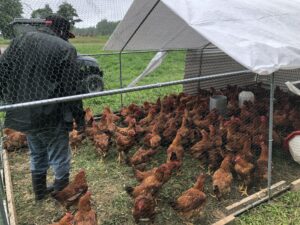
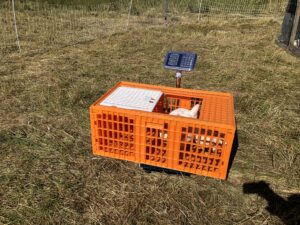
Milestone 4 - Engagement, Learning, and Evaluation: In Progress
- Participants: 125 current and potential pasture-raised broiler producers
- What farmers will learn or do: Farmers will participate in scheduled and peer-to-peer learning through the pastured broiler field days. The scheduled program will cover feeding schedules and types of feeds; management to limit mortality and promote growth; enterprise budgeting; and an opportunity to gain hands-on practice with further processing techniques allowed under the 1,000 bird exemption. Farmers will fill out the pre-and post field day verification tool.
- Proposed completion date: December 2023
- Project Team involvement: Amy and one additional educator will secure the farms, plan and host the field days, and teach the presentations/demonstrations. Amy will distribute the verification tool and collect & evaluate the survey data.
In 2023, we were able to schedule and host 2/5 broiler field days. We were challenged with low registrations for the in-person field days, and while we hosted one in-person, we canceled the other three that we had scheduled and rescheduled those in 2024. We think that the reason for the low registrations was because of the time of year (Fall) and it coincided with back-to-school and year-end burnout. We're hoping that by rescheduling the remaining field days for this spring, we'll be able to get more registrants. The locations for the field days have been secured for 2024.
The meeting that we moved forward with holding in-person in 2023 was at HLW Acres Poultry Processing in Attica, NY. In addition to the scheduled programming, participants had the opportunity to tour a certified 5A poultry processing facility. We had 8 individuals in attendance.
Due to the low in-person registration numbers, we decided to have one virtual broiler field day on September 20, 2023. This was unique because in addition to the concepts learned at the in-person field days, we used the support of the Cornell Small Farms Farm Ops Program to record videos of humane poultry handling and processing that were shared with participants. This program had 31 registrants and the YouTube recording has 86 views since it was uploaded. This video was shared as part of Cornell's Livestock Program Work Team video archive to provide a reference to producers looking for research-based processing resources. You can view the recording here: https://www.youtube.com/watch?v=RyH61R8rSCc&t=5597s. Feedback from this webinar requested a follow-up webinar on regulations surrounding labeling and packaging poultry, which is tentatively planned for late March 2025.
In 2024, we were able to host 3 additional in-person broiler field days. The first was held at Sunny Cove Farm in Alfred, NY on 6/6/24 and had 12 participants. The second was hosted at Green Heron Growers in Panama, NY on 9/17/24 and had 7 participants. The final field day was hosted at Laughing Earth Farm in Cropseyville, NY on 8/19/24 with 14 participants.
Amy is in the process of collecting and evaluating the survey data from the first two field days for the final report.
Amy was invited to teach broiler production and processing as part of a Women for the Land learning circle in 2024. She partnered with Kate Geiger from Boston Hills Farm in Hamburg, NY for the 4 hour education session and reached 13 women farmers. This program was hosted on 7/11/24.
In terms of presenting general guidelines for broiler production, processing, and pricing to a large, diverse farmer/educator audiences, including preliminary results, Amy presented at the following conferences:
- Catskills Regional Ag Conference on 1/13/23 (40 individuals)
- Northeast Grazing Network Annual Conference on 1/7/24 (25 individuals)
- Cornell Cooperative Extension In-Service on 11/19/24 (20 individuals)
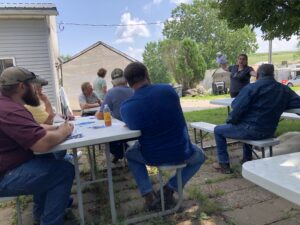
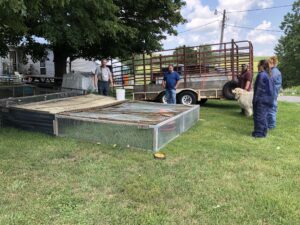
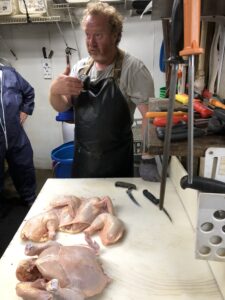
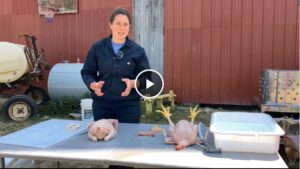
Milestone 5 – Learning: Complete
- Participants: 10 additional farms, 30 original farms
- What farmers will learn or do: Farmers will be provided with their data and discuss changes in production, management, pricing, and markets which will or have yielded a profitability increase. They will join a Zoom call to discuss these changes with other farmers and compare their data to the average benchmark of farms on the project.
- Proposed completion date: March 2024
- Project Team involvement: Katelyn will provide enterprise summaries, and educators will provide feedback to their farms. Amy will lead the discussion group.
Our team collected and evaluated the data from the project farms from January - March 2024. Farmers received their individualized reports in April 2024. The first cohort of farmers had their discussion circle to see what their changes in year 1 had on their operations and statewide benchmarks in year 2 on 4/11/24. The second cohort of farmers had their first discussion circle to share their baseline data and benchmarks on 4/16/24.
Milestone 6 – Evaluation: Complete
- Participants: 30 original farms
- What farmers will learn or do: Farmers will take post-project survey to provide their new baseline for budgeting, costs of production, and their updated prices.
- Proposed completion date: March 2024
- Project Team involvement: Educators will distribute the survey. Amy will collect and evaluate the data.
The survey for participating farms was included as part of their project binders. This data was collected and is being evaluated with the data from the second cohort to be shared in the final report.
Milestone 7 – Engagement: Complete
- Participants: 10 additional farmers
- What farmers will learn or do: The second cohort of 10 farmers will collect year 2 production and pricing data.
- Proposed completion date: October 2024
- Project Team involvement: Educators will collect production and cost data with the farm and provide support as needed.
I have corrected a type-o in the milestone above to reflect that the second cohort of farmers did for this milestone, not the first cohort.
Coming into the second cohort's second year, we had three farms remove themselves from the project. After completing the year 1 data, the first farm realized that their costs of production outweighed what they were able to charge and discontinued raising broilers. Two additional farmers had challenges unrelated to the project that prevented them from participating in the project in year 2. That left us with 13 farms coming into year 2.
This year was a high predation year, which means less data was collected than in previous years. Two of the project farms lost both flocks from predation, resulting in no data for the 2024 collection year. One other farm had 100% of one of their flocks lost to predation. While unfortunate that so many farms lost flocks on the project this year, it's not unusual from what we're finding. The death rates from predators are very high in broiler chickens, which is mostly due to unsecured chicken tractors and brooder pens, following recommendations for open bottomed chicken tractors from farmer influencers and brooders in open barns. Both have become ubiquitous with the pastured chicken movement. This topic is something that we're going to evaluate in more detail for the final report, since it's such a huge, unanticipated loss for farmers, and share recommendations for keeping chickens more secure in our final report.
Many of these farmers took the one-on-one training from year 1 and applied it to their production scheme in year 2, which was really exciting! There was some additional support needed for some of the farms, which was provided by the educators.
Milestone 8 – Evaluation: In Progress
- Participants: 125 field day participant farmers recruited, 42 expected to answer the survey.
- What farmers will learn or do: Farmers will take post-field day survey, distributed 12 months out from the date of completion of each field day to provide the project team with each’s updated baseline for budgeting, costs of production, and their current pricing.
- Proposed completion date: December 2024
- Project Team involvement: Educators will distribute the survey. Amy will collect and evaluate the data.
Because the field days fell over the course of two years rather than one, the majority of these surveys are being sent out this summer. The results of the surveys will be combined and shared in the final report.
Milestone 9 – Engagement, Learning, and Evaluation: Not Begun
- Participants: 50 current or potential pasture-raised broiler farmers will participate in one of 2 pastured broiler webinars
- What farmers will learn or do: Farmers will learn how to manage production costs, including feeding schedules and types; management to limit mortality and promote growth; enterprise budgeting; and value-added processing as well as gain tips on identifying markets and raising prices.
- Proposed completion date: January 2025
- Project Team involvement: Amy and Katelyn will develop and teach the webinars. Amy will distribute the verification tool and collect & evaluate the survey data.
We plan to host these in April/May of 2025. That way, we have time to analyze all of the data from the project and provide attendees with the project's results, including state-wide averages for producing and pricing chicken meat.
Milestone 10 – Learning: In Progress
- Participants: 10 additional farms
- What farmers will learn or do: Farmers will be provided with their data and discuss changes they’ve made in production, management, pricing, and markets which have yielded a profitability increase. They will join a Zoom call to discuss these changes with other farmers and compare their data to the average benchmark of farms on the project.
- Proposed completion date: December 2025
- Project Team involvement: Katelyn will provide enterprise summaries. Educators will provide enterprise feedback to their assigned farmers. Amy will lead the discussion group.
Katelyn and I are in the process of collecting data binders and analyzing the data for the second cohort's second year on the project. Our discussion circle for these farmers is tentatively planned for 3/28/25.
Milestone Activities and Participation Summary
Educational activities:
Participation Summary:
Performance Target Outcomes
Target #1
We will verify learning from the 40 farmers on the project through a pre-participation and post-participation survey, which will include estimates of the costs of production and profitability per bird. Flock costs of production and income values collected by educators and evaluated by our team's farm business management specialist will verify what has been shared in the survey; these numbers will be used to show the difference in profitability per bird from year 1 to year 2.
Evaluation of learning from the webinars and field days will be assessed through three surveys (before, immediately following, and 12 months out from program completion [field days only]) to determine significant changes in understanding, attitudes, practices, and flock income and how they change over time.
The verification survey tool has four major sections:
- Familiarity with different concepts around budgeting and raising broilers
- Level of agreement with statements regarding profitability of broiler enterprises
- How standard costs of production affect their enterprise
- Current price of their broilers and estimated production costs.
Additional Project Outcomes
None at this time.
Comments from some of our farmers:
"We GREATLY appreciate taking part in this project. Previous to COVID, we had averaged around 500 birds/year and, with this partnership, decided to ramp up again following a 3 year break. So far, so good. We’ve sold almost all the birds we raised for this program and have received good feedback."
"I now know the amount of money we weren't capturing on chicken because thighs and drums don't sell as well as breast meat. We've changed our pricing scheme to make the money back from the breast meat, and then whatever we sell from the rest of the bird is profit."
"This process has been very eye-opening... I almost want to take data on everything!"
"We're not going to raise chicken next year. Our freezer space is better spent on storing pork, which is very profitable for us."
"It was an interesting day! I learned a bunch about cutting up birds efficiently."
None at this time.